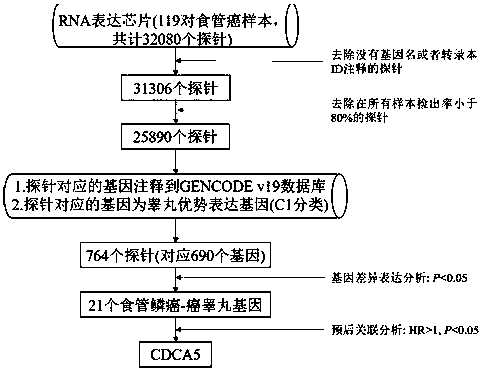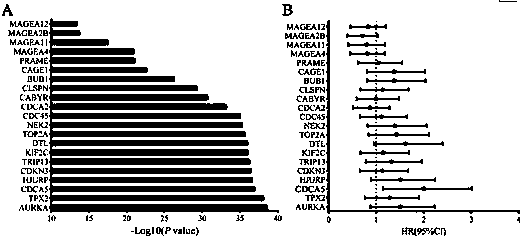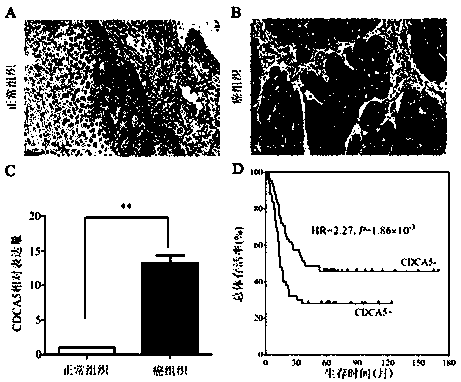Cancer/testis antigen CDCA5 as esophageal squamous cell carcinoma prognostic marker and esophageal squamous cell carcinoma prognostic marker therapeutic target
A prognostic marker, esophageal squamous cell carcinoma technology, applied in recombinant DNA technology, DNA/RNA fragments, determination/examination of microorganisms, etc.
- Summary
- Abstract
- Description
- Claims
- Application Information
AI Technical Summary
Problems solved by technology
Method used
Image
Examples
Embodiment 1
[0064] Example 1 Screening method of cancer-testis gene CDCA5
[0065] See figure 1 , Based on the previously published transcriptome chip data of the Chinese Han population, GEO database, number: GSE53625, from the 32080 original probes on the chip, the probes without gene name or transcript ID annotations and in all 119 pairs of tissue samples are removed The detection rate is less than 80% of the probes, and the remaining 25,890 probes, from which the genes encoding the protein and genes that are predominantly expressed in the testis are screened out.
[0066] The specific method is based on the GENCODE v19 database search to screen out the genes that can code for the protein; compare the 1,336 genes we found in the earlier stage that show dominant expression in testicular tissue, and further retain 764 probes, corresponding to 690 dominant testicular genes; , 21 cancer-testis genes are differentially expressed in esophageal cancer and adjacent tissues, that is, FoldChange ≥ 2 &...
Embodiment 2
[0068] Example 2 Tissue biology test
[0069] 118 cases of esophageal squamous cell carcinoma patients with cancer and adjacent tissues were extracted from Jiangsu Provincial People's Hospital. All patients in the group had not received radiotherapy or chemotherapy before surgery and had complete clinical and pathological data and prognostic follow-up data. After embedding in paraffin, all tissue specimens were first stained with hematoxylin and eosin to confirm that the paraffin tissue block was esophageal squamous cell carcinoma or paracancerous tissue, and the immunohistochemical tissue chip method was used to detect the 118 cases of primary esophagus The expression level of CDCA5 protein in squamous cell carcinoma and paracancerous tissues was then sectioned to select representative areas. Cancer cells in the tumor area were more than 80%, and cancer cells in the paracancerous area were 0.
[0070] For each specimen, the cancer tissue or the adjacent tissues are selected twice,...
Embodiment 3
[0084] Example 3 Expression detection of CDCA5 gene
[0085] Human esophageal squamous cell carcinoma cell lines TE1, Eca109, KYSE30, KYSE70, KYSE150, KYSE180, KYSE410, KYESE450, KYSE510 and normal esophageal epithelial cells HET-1a were purchased from Shanghai Jikai Biological Company, and the cells were cultured. The cells are subjected to RNA extraction and PCR detection.
[0086] The primers of the CDCA5 gene were designed by Guangzhou RiboBio, as follows:
[0087] Upstream primer: 5’-AGAAAGTCAGGCGTTCCTACAG -3’;
[0088] Downstream primer: 5'-GGGAGATTCCAGGGAGAGTCAT -3'.
[0089] Use GAPDH mRNA as an internal control, use 2 -ΔCt Method to calculate the target gene expression level. All samples were repeated three times on the LightCycler480 PCR machine.
[0090] See Figure 5 , PCR results showed that compared with normal esophageal epithelial cells, esophageal squamous cell carcinoma Eca109 and KYSE30 cell lines have higher CDCA5 gene expression.
PUM
 Login to View More
Login to View More Abstract
Description
Claims
Application Information
 Login to View More
Login to View More - R&D
- Intellectual Property
- Life Sciences
- Materials
- Tech Scout
- Unparalleled Data Quality
- Higher Quality Content
- 60% Fewer Hallucinations
Browse by: Latest US Patents, China's latest patents, Technical Efficacy Thesaurus, Application Domain, Technology Topic, Popular Technical Reports.
© 2025 PatSnap. All rights reserved.Legal|Privacy policy|Modern Slavery Act Transparency Statement|Sitemap|About US| Contact US: help@patsnap.com



